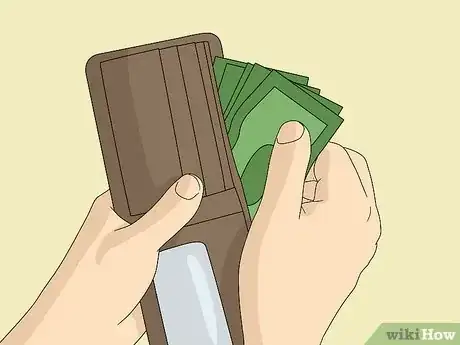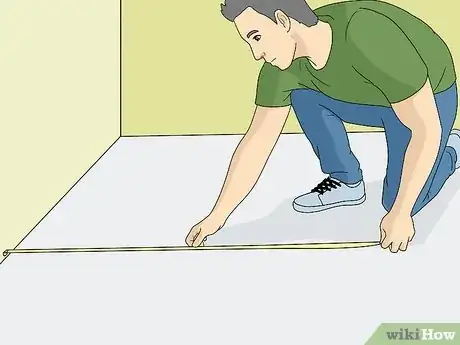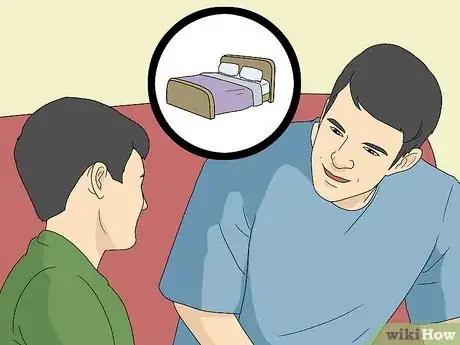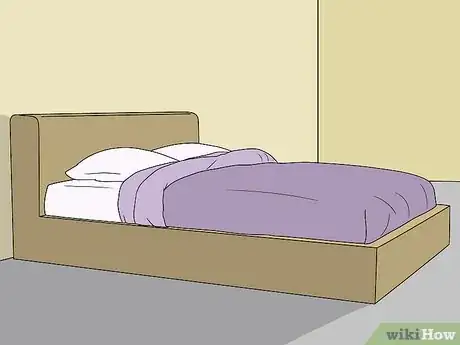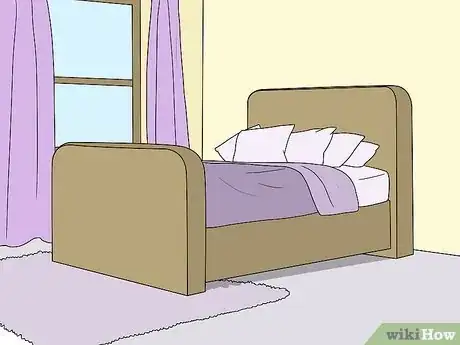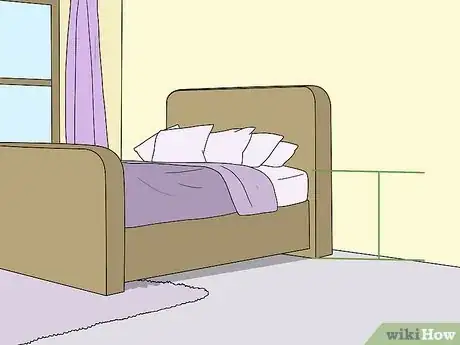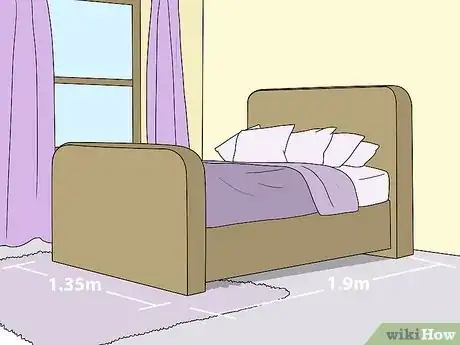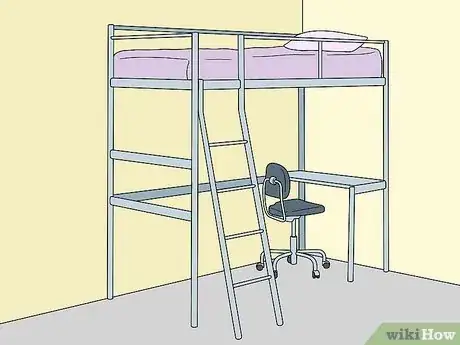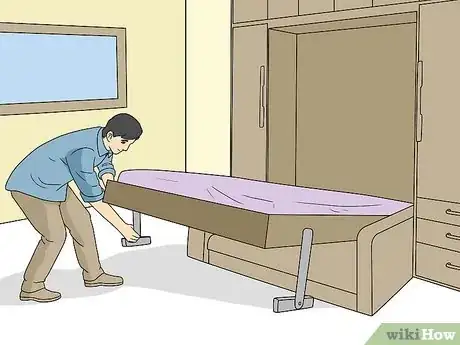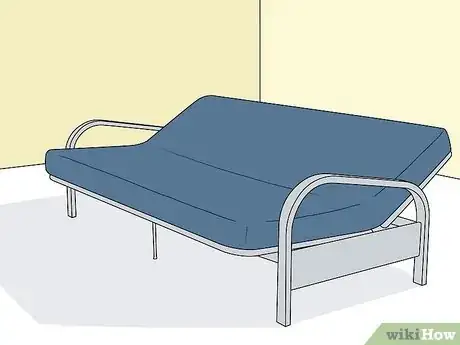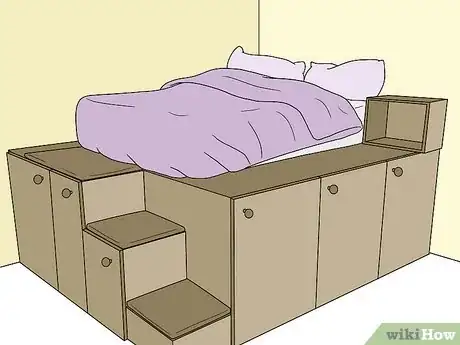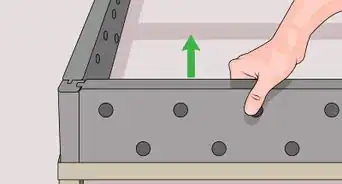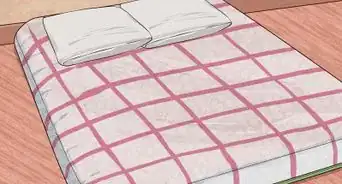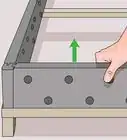This article was co-authored by Katherine Tlapa. Katherine Tlapa is an interior designer, currently working as a Design Specialist for Modsy, a design service based in San Francisco. She also runs her own DIY Home Design blog, My Eclectic Grace. She received her BFA in Interior Architecture from Ohio University in 2016.
There are 8 references cited in this article, which can be found at the bottom of the page.
This article has been viewed 21,443 times.
If you've never had to buy a bed before, you might be at a loss for how to choose the right size one for yourself. This may seem like a simple task, but there are many factors to consider, like who the bed will be used by and the amount of space available. In any case, you'll need to plan for your new bed before you choose the right size one for yourself. After that, you can get the most out of your bed with space optimization techniques.
Steps
Planning for a New Bed
-
1Establish a budget. New furniture, like a bed, can be very expensive. By establishing a budget, you'll prevent yourself from overspending. In many cases, you can even narrow down online search results to only show models in your budgeted range.
- By using online search features that narrow down models of bed according to price, you'll also save yourself from becoming too attached to models outside your price range.[1]
- When you're creating your budget, consider if this bed will be an investment piece you will use for years, or if you just need an expensive piece of furniture to meet your basic needs. This can help you decide the most you are willing to spend.
-
2Measure how much space for the bed is available. Before you make any new bed purchases, you'll need to measure the space available in your room. Some beds may be too large for small rooms, or some beds may be too wide for narrow spaces.
- Take a tape measure and determine the length and width of available space in your room.
- Think about the space a person will need to move around the room freely. A bed that is too big may make it difficult to move easily through the room. Make sure you have at least a 3 ft (0.91 m) walking path along the sides and end of your bed.
- Note any protruding parts of the room, like low sills or pronounced molding. These can create obstacles for higher beds.[2]
Advertisement -
3Prioritize beds that suit their occupants. Beds intended for elderly occupants might need to be lower in height. Children may want specialty beds, like bunk beds, canopy beds, or beds shaped like racing cars or spaceships. High school students might want loft beds they can take to college in a few years.
- If possible, you may want to ask the person who will be sleeping in the bed what kind of bed they would enjoy most.[3]
-
4Account for your current situation and future plans. If you're just starting out life as a young person, you'll probably want an economic, durable bed that fits relatively small spaces. You may not have much space in your dorm room or in the bedroom of a shared apartment, so smaller beds would be ideal in this case. However:[4]
- If you are more established in your career, have a romantic partner, are planning on getting married, or are in a similar situation, a larger bed will likely be preferable.
- If you are buying a bed for a child, consider their future needs. Children grow quickly, so a bed may not suit them long if it's not convertible to a larger model. You might decide to invest in a crib that converts into a toddler bed and then a full-size bed to accommodate your child as they grow up.
- If the bed you are buying is for a guest room and you only intend on using it for a guest room, a generic bed would likely be best.[5]
Selecting a Bed
-
1Match your bed style with the bedroom decor. You can always re-paint a room to change its color scheme to suit the tones of your furniture, but the furniture you'll be pairing with your new bed should be taken into consideration as well. Generally, furniture of similar style and construction work well as a whole set. For example:[6]
- If the majority of the furniture in the room you'll be adding a bed to is made of a dark wood, like black walnut, you might choose a bed made of a similar material.
- If most of your furniture is black, you might achieve a contemporary look with a bed that has a black painted wooden frame.
- If you enjoy switching up your decor often, choose a neutral bed that will fit with different styles. For example, you might choose a basic white frame or pale wood.
-
2Take height into consideration. You may have accounted for height when thinking about the bed's occupant, but the height of your bed also plays a crucial role in storage and comfort. Taller beds will not only be more comfortable for taller people, but will also have more storage space underneath.
- You may have to take wall protrusions into consideration when thinking about bed height. For example, a room with a low protruding sill might accommodate a low bed but not a high one.[7]
-
3Find the bed size right for you. Different sizes of bed suit different age groups and phases of life. Young kids, for example, won't need more than a crib or toddler mattress. A twin mattress should be suitable for most older children and young adults. Twin mattresses can be small for adults, in which case the twin XL, an excellent choice for tight spaces, is best. Common sizes beyond these include:
- Full beds, sometimes called doubles, are 53" (1.35 m) wide and approximately 75" (1.9 m) long. This bed may be short for some adults.
- Queen beds are generally 60" (1.52 m) wide and 80" (2.03 m) long. The extra space in queen sizes make it a better fit for couples.
- King size beds will be about 76" (1.93 m) wide and 80" (2.03 m) long. This allows for the most space a couple can have with a single bed.
- California King size beds are mostly available on the west coast. These beds are 4" (10.2 cm) narrower but 4" (10.2 cm) longer.[8]
-
4Try out potential mattresses before buying one. You never know how a bed will feel until you lay down on it yourself. Even if you plan on buying a mattress online, you should head to a brick-and-mortar mattress store to try it out before purchasing. Test mattresses by:
- Removing your shoes and positioning yourself as you would normally lay down on your bed.
- Changing your position several times, allowing your weight to settle after each time you re-position yourself.
- Taking your time while laying on the bed. It may take you up to 15 minutes before you are fully settled on the mattress.[9]
Getting the Most out of Your Bed
-
1Optimize space saving with lofts. A loft is a kind of bed that is raised off the ground. To get into this kind of bed you usually climb into it with a ladder.[10] Loft beds allow you to store furniture, like desks, shelving, and seating, beneath your bed.
- Many furniture stores sell pre-made lofts. These can usually be assembled with simple tools.
- If you're somewhat handy and are looking to save some money, you might build your own loft bed.
- Lofts are a great option for small studio apartments because they allow you to use more of your vertical space. They also work well for pre-teens, teens, and college students who benefit from having a workspace under their bed.
-
2Utilize hideaway beds to make bedrooms multi-purpose. If you have less space in your home, you might want your spare bedroom to double as an office, a puzzle room, a TV room, and so on. Some beds fold up out of sight so that you can use a room for purposes besides a bedroom. Use these to get more function out of your rooms.
- Some hideaway beds are designed to fold into walls. You may want to make use of this option to make your spare bed all but disappear when it's not in use.[11]
-
3Use a futon to utilize your bed as a couch. Western style futons are a special kind of bed that can also fold into a couch. If you don't have a spare room for guests, a futon in your family room or living room can be used as a bed when necessary.
- When considering a futon, prioritize models with plush, durable cushioning. Futons with poor cushioning can be quite uncomfortable.
-
4Invest in a bed with built features. Some beds have built in storage, like drawers and cubbies.[12] Other kinds of bed may have furniture attached or built in, like a desk or bookshelf.[13] These kinds of bed can be expensive, but can save you the cost of having to buy a separate piece of furniture down the road.
Things You'll Need
- Tape measure
References
- ↑ http://bettersleep.org/mattresses-and-more/choosing-the-best-mattress/
- ↑ http://homedesignlover.com/home-furniture/choosing-the-right-bed/
- ↑ http://homedesignlover.com/home-furniture/choosing-the-right-bed/
- ↑ http://homedesignlover.com/home-furniture/choosing-the-right-bed/
- ↑ https://sleep.org/articles/size-bed-choose/
- ↑ http://homedesignlover.com/home-furniture/choosing-the-right-bed/
- ↑ http://homedesignlover.com/home-furniture/choosing-the-right-bed/
- ↑ http://bettersleep.org/mattresses-and-more/mattress-sizes
- ↑ http://bettersleep.org/mattresses-and-more/choosing-the-best-mattress/
- ↑ http://www.bobvila.com/slideshow/10-space-saving-solutions-for-tiny-bedrooms-47532/white-bunk-bed
- ↑ http://www.designrulz.com/design/2015/06/25-ideas-of-space-saving-beds-for-small-rooms/
- ↑ http://www.bobvila.com/slideshow/10-space-saving-solutions-for-tiny-bedrooms-47532/platform-bed
- ↑ http://www.bobvila.com/slideshow/10-space-saving-solutions-for-tiny-bedrooms-47532/lofted-bed-and-desk
